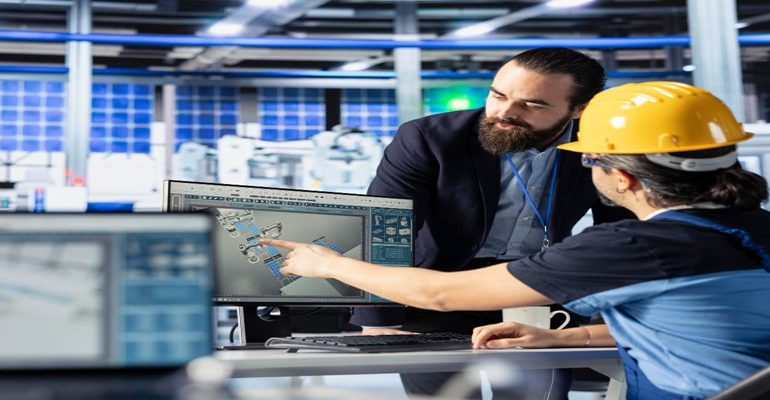
Industrial AI: A Competitive Advantage for Modern Manufacturers

Industrial AI: A Competitive Advantage for Modern Manufacturers
Automation was the buzzword of the early 2000s when discussing artificial intelligence in several businesses. As we go forward to 2025, the scene is very different. Industrial AI is now about building intelligent ecosystems where humans and machines co-create, co-learn, and co-evolve, not only about displacing human labor.
Welcome to the second wave of industrial intelligence, when factories are sentient rather than merely intelligent.
The Transition to Freedom from Automation
Deterministic in nature, traditional automation produced fixed outputs when given fixed inputs. On the other hand, ambiguity is what industrial AI feeds on. These days, AI agents may anticipate maintenance problems before they arise, modify production lines instantly in response to supply chain interruptions, and even suggest novel product ideas based on actual data.
For example, AI-powered turbines at Siemens Energy dynamically modify settings without human involvement while they operate. On the manufacturing floor, it’s evolution rather than simply maintaining.
Digital Twins with Dreams
Digital twins are changing from static simulations to dynamic, self-improving models. Consider a chemical plant’s digital twin that not only replicates the actual facility but also runs millions of parallel scenarios all night long to determine which settings optimize production while minimizing environmental effect.
Through the integration of AI models, IoT devices, and people into a dynamic digital environment, NVIDIA’s Omniverse is spearheading this change. “Digital Dream Factories” virtual locations where optimization takes place around-the-clock—will soon be available to businesses, opening possibilities that human planners could never manually discover.
AI in Industry as a New R&D Partner
Human engineers are no longer the only ones who can create products. These days, AI bots are able to collaborate with human teams to co-create by offering enhancements, modeling materials, and suggesting supply chain efficiencies.
Consider General Motors, whose artificial intelligence (AI) systems proposed organic, bone-like architectures for auto parts that were stronger and lighter than human designs. Businesses reduce R&D timelines by 40–60% by using AI as a design partner rather than a tool.
In the factories of the future, products will be imagined rather than manufactured.
Robots that collaborate (Cobots) and possess emotional intelligence
For safety, industrial robots were once kept apart from people in cages. However, the latest generation of AI-powered cobots collaborates with people, recognizing their facial expressions, gestures, and even stress levels.
Cobots with “emotional AI,” developed by startups like Neura Robotics, are able to recognize when a human worker is irritated or worn out and automatically slow down or provide help.
Your robot in the future factory will recognize when you need a wrench, not just pass one to you.
The New KPI for Ethical AI
A sense of responsibility accompanies high intelligence.
Industrial AI has to be straightforward, comprehensible, and devoid of prejudice. To ensure that automated judgments can be reviewed and comprehended, businesses such as Bosch are investing in “Responsible AI” technologies. The importance of AI governance is on par with that of operational excellence.
More and more, factories are being judged on how ethically they produce their goods in addition to their productivity. Trust is the most important KPI in the age of industrial AI.
The Manufacturing Metaverse
What if maintenance personnel didn’t have to go to nuclear power stations or hazardous oil rigs? Workers may now “beam into” virtual versions of these locations, diagnose issues remotely, and even perform virtual repairs using AI-powered digital hands thanks to Industrial AI-powered metaverse systems.
Teams from different continents may now work together digitally in real time thanks to a new partnership between Accenture and Mars, Inc. to create a digital twin of a whole candy production plant.
With the help of industrial AI, telepresence will soon be more than simply a video call; it will be a multisensory experience.
Predictions for the Future: Adaptive Industries
By 2030, factories will behave more like living things—adaptive, learning, and ever-changing—than like inflexible structures. Human labor, robotics, AI models, and sensors will all function in a smooth digital-physical continuum.
Anticipate factories that:
- Anticipate worldwide supply chain hazards before they materialize.
- Overnight, they automatically adjust their configuration for various product lines.
- AI-generated tutors and augmented reality can be used to train human workers on-demand.
- Dynamically lower their carbon footprint by making minute-by-minute adjustments to procedures.
Human society was once altered by the Industrial Revolution. This time, industrial artificial intelligence is creating a world that develops, learns, and dreams with us.
Conclusion
Factories are becoming sophisticated, adaptable ecosystems thanks to industrial AI. Businesses that use AI now will spur innovation, increase productivity, and set the standard for manufacturing in the future. The smart industry age has begun, and it will be shaped by those who are prepared to change.